Files in this item
Evolving mantle sources in postcollisional early Permian-Triassic magmatic rocks in the heart of of Tianshan Orogen (western China)
Item metadata
| dc.contributor.author | Tang, Gong-Jian | |
| dc.contributor.author | Cawood, Peter A. | |
| dc.contributor.author | Wyman, Derek A. | |
| dc.contributor.author | Wang, Qiang | |
| dc.contributor.author | Zhao, Zhen-Hua | |
| dc.date.accessioned | 2018-05-24T23:32:50Z | |
| dc.date.available | 2018-05-24T23:32:50Z | |
| dc.date.issued | 2017-11 | |
| dc.identifier | 251464736 | |
| dc.identifier | b9d59199-095a-4b71-9f0f-184df96b5546 | |
| dc.identifier | 85035064046 | |
| dc.identifier | 000418403800022 | |
| dc.identifier.citation | Tang , G-J , Cawood , P A , Wyman , D A , Wang , Q & Zhao , Z-H 2017 , ' Evolving mantle sources in postcollisional early Permian-Triassic magmatic rocks in the heart of of Tianshan Orogen (western China) ' , Geochemistry, Geophysics, Geosystems , vol. 18 , no. 11 , pp. 4110-4122 . https://doi.org/10.1002/2017GC006977 | en |
| dc.identifier.issn | 1525-2027 | |
| dc.identifier.other | Bibtex: urn:9e53877eb89dca87cf6d8c66f5d34829 | |
| dc.identifier.uri | https://hdl.handle.net/10023/13533 | |
| dc.description | This work was supported by funding from the Strategic Priority Research Program (B) of the Chinese Academy of Sciences (grant nos. XDB18020204 and XDB03010600), the National Natural Science Foundation of China (grant nos. 41673033, 41630208, and 41202041), the Key Program of the Chinese Academy of Sciences (QYZDJ–SSW–DQC026), and GIGCAS 135 project 135TP201601. Peter Cawood acknowledges support from the Natural Environment Research Council (grant NE/J021822/1) and from the Australian Research Council (grant FL160100168). The senior author thanks the NSC, Taiwan, for a grant which supported his one-year academic visit at the NTU. | en |
| dc.description.abstract | Magmatism post-dating the initiation of continental collision provides insight into the late stage evolution of orogenic belts including the composition of the contemporaneous underlying subcontinental mantle. The Awulale Mountains, in the heart of the Tianshan Orogen, display three types of post-collisional mafic magmatic rocks. (1) a medium to high K calc-alkaline mafic volcanic suite (∼ 280 Ma), which display low La/Yb ratios (2.2 – 11.8) and a wide range of εNd(t) values from +1.9 to +7.4. This suite of rocks was derived from melting of depleted metasomatized asthenospheric mantle followed by upper crustal contamination. (2) Mafic shoshonitic basalts (∼ 272 Ma), characterized by high La/Yb ratios (14.4 – 20.5) and more enriched isotope compositions (εNd(t) = +0.2 – +0.8). These rocks are considered to have been generated by melting of lithospheric mantle enriched by melts from the Tarim continental crust that was subducted beneath the Tianshan during final collisional suturing. (3) Mafic dikes (∼ 240 Ma), with geochemical and isotope compositions similiar to the ∼280 Ma basaltic rocks. This succession of post-collision mafic rock types suggests there were two stages of magma generation involving the sampling of different mantle sources. The first stage, which occurred in the early Permian, involved a shift from depleted asthenospheric sources to enriched lithospheric mantle. It was most likely triggered by the subduction of Tarim continental crust and thickening of the Tianshan lithospheric mantle. During the second stage, in the middle Triassic, there was a reversion to more asthenospheric sources, related to post-collision lithospheric thinning. | |
| dc.format.extent | 13 | |
| dc.format.extent | 2589776 | |
| dc.language.iso | eng | |
| dc.relation.ispartof | Geochemistry, Geophysics, Geosystems | en |
| dc.subject | Post-collisional | en |
| dc.subject | Mantle evolving | en |
| dc.subject | Basalt | en |
| dc.subject | Shoshonite | en |
| dc.subject | Tianshan Orogen | en |
| dc.subject | GE Environmental Sciences | en |
| dc.subject | QE Geology | en |
| dc.subject | DAS | en |
| dc.subject.lcc | GE | en |
| dc.subject.lcc | QE | en |
| dc.title | Evolving mantle sources in postcollisional early Permian-Triassic magmatic rocks in the heart of of Tianshan Orogen (western China) | en |
| dc.type | Journal article | en |
| dc.contributor.sponsor | NERC | en |
| dc.contributor.institution | University of St Andrews. School of Earth & Environmental Sciences | en |
| dc.contributor.institution | University of St Andrews. Scottish Oceans Institute | en |
| dc.contributor.institution | University of St Andrews. St Andrews Isotope Geochemistry | en |
| dc.identifier.doi | 10.1002/2017GC006977 | |
| dc.description.status | Peer reviewed | en |
| dc.date.embargoedUntil | 2018-05-24 | |
| dc.identifier.grantnumber | NE/J021822/1 | en |
This item appears in the following Collection(s)
Items in the St Andrews Research Repository are protected by copyright, with all rights reserved, unless otherwise indicated.

